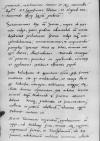Letter #1918
Stanisław AICHLER to Ioannes DANTISCUSCracow (Kraków), 1538-09-13
| received [1538]-09-23 Manuscript sources:
| ||||
Text & apparatus & commentary Plain text Text & commentary Text & apparatus
Reverendissimo in Christo Patri Domino, domino
Post humillimam et perpetuam sui commendationem, omne felicitatis incrementum optat.
Reverendissime Domine, Maecenas munificentissime.
Nolui commitere, quin ad Reverendissimam Dominationem Tuam, quantumvis rudes litteras exararem, maxime cum famulus Reverendissimae Dominationis Tuae (qui quidem in parentis aedes divertit) hinc reditum pararet, ne si tam opportunam scribendi facultatem intermitterem, id meae ingratitudini, ne dicam stultitiae, merito assignaretur. Equidem illud immortale beneficium, quo me Reverendissima Dominatio Tua hinc discedens locupletissime ornavit, alto pectore fixum manet. Ac mediusfidius interea, mihi nil est magis in optatis, quam ut possim qualiter qualem demerendi occasionem arripere, quam si aliquando consecutus fuero, me gratum et memorem, Reveredissima Dominatio Tua sentiet. Sed malim re ipsa meum istiusmodi animum quam calami stratis verbis, quae mihi quoque desunt, declarare. Itaque rem ipsam, quae voluntatem egregiam comprobet, summo cum desiderio, omni cum diligentia expectabo et iocunda promptitudine offeram.
Etsi me non lateat omnia quae hic vel geruntur, vel audiuntur, a maximis viris certissime Reverendissimae Dominationi Tuae
 BCz, 1597, p. 114
perscribi, nihilominus tamen et ego nonnula Reverendissimae Dominationi Tuae significare statui, ut aliquod tantummodo officii signum praeberem.
BCz, 1597, p. 114
perscribi, nihilominus tamen et ego nonnula Reverendissimae Dominationi Tuae significare statui, ut aliquod tantummodo officii signum praeberem.
Inter
Aiunt  BCz, 1597, p. 115
Decrevit
BCz, 1597, p. 115
Decrevit
De meo statu quaedam adscribere placuit.
Quod superest, enixe Reverendissimam Dominationem Tuam oro, dignetur ignoscere meae sat ineptae ac nimium familiari verbositati, in quam (illectus innata facilitate et perspecta gratia Reverendissimae Dominationis Tuae) incidi. Ac demum illud unum enixissime a Reverendissima Dominatione Tua contendo, velit me in clientulorum suorum album reponere, quo mihi profecto nil antiquius nil optatius esse potest. Deus Optimus alacrem amoenam et felicem vitam Reverendissimae Dominationi Tuae in longum proroget, ex animo etiam atque etiam precor.
Dat(ae) or Dat(um)⌈Dat(ae)Dat(ae) or Dat(um)⌉
Eiusdem Reverendissimae Dominationis addictissimus clientulus doctor



